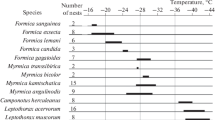Abstract
Earthworm cocoons are mostly found in the uppermost soil layers and are therefore often exposed to low temperatures during winter. In the present study, cocoons of five taxa of earthworms were investigated for their tolerance to freezing, melting points of cocoon fluids and dehydration of cocoons when exposed to a frozen environment. Embryos of the taxa investigated were freeze intolerant. The melting points of fully hydrated cocoon fluids were high (above −0.3°C) and thermal hysteresis factors were absent. Exposure to a frozen environment caused the cocoons to dehydrate drastically and dehydrated cocoons showed significantly lower super-cooling points than fully hydrated cocoons, reducing the risk of freezing for dehydrated cocoons. It is proposed therefore that the cold-hardiness strategy of the earthworm cocoons is based on dehydration upon exposure to subzero temperatures in the frozen environment. Cocoons of three surface-dwelling taxa, Dendrobaena octaedra, Dendrodrilus rubidus tenuis and Dendrodrilus rubidus norvegicus had lower supercooling points and survived frost exposure better than cocoons of two deeper-dwelling taxa, Aporrectodea caliginosa and Allolobophora chlorotica. One of the investigated taxa, D. r. norvegicus, was collected from a cold alpine habitat. However, it was not more cold hardy than the closely related D. r. tenuis collected from a lowland temperate habitat. D. octaedra was the most cold hardy taxon, its cocoons being able to withstand −8°C for 3 months and −13.5°C for 2 weeks in frozen soil.
Similar content being viewed by others

Abbreviations
- dw:
-
dry weight
- fw:
-
fresh weight
- SCP:
-
supercooling point
References
Asahina E (1969) Frost resistance in insects. Adv Insect Physiol 6:1–49
Block W (1982) Cold hardiness in invertebrate poikilotherms. Comp Biochem Physiol 73A:581–593
Holmstrup M (1992) Cold hardiness strategy in cocoons of the lumbricid earthworm Dendrobaena octaedra (Savigny). Comp Biochem Physiol 10A:49–54
Holmstrup M, Hansen BT, Nielsen A, Østergaard IK (1990) Frost tolerance of lumbricid earthworm cocoons. Pedobiologia 34:361–366
Holmstrup M, Østergaard IK, Nielsen A, Hansen BT (1991) The relationship between temperature and cocoon incubation time for some lumbricid earthworm species. Pedobiologia 35:179–184
Hopp H (1947) The ecology of earthworms in cropland. Proc Soil Sci Am 12:503–507
Huhta V (1978) Mortality in enchytraeid and lumbricid populations caused by hard frosts. Proc Symp: “Adaptions of animals on winter conditions”. Moscow
Lee KE (1985) Earthworms. Their ecology and relationships with soils and land use. Academic Press, Sydney
Lee RE (1991) Principles of insect low temperature tolerance. In: Lee RE, Denlinger D (eds) Insects at low temperature. Chapman and Hall, New York, pp 17–46
Oglesby LC (1969) Inorganic components and metabolism; ionic and osmotic regulation: Annelida, Sipuncula and Echiura. In: Florkin M, Scheer BT (eds) Chemical zoology, vol IV: Annelida, Echiura and Sipuncula. Academic Press, New York, pp 211–310
Satchell JE (1980) R worms and K worms: a basis for classifying lumbricid earthworm strategies. In: Dindal DL (ed) Soil biology as related to land use practises. Proc VII Int Coll Soil Zool, pp 848–864
Schmidt-Nielsen K (1990) Animal physiology. Adaptations and environment, 4th edn. Cambridge University Press, Cambridge, UK
Stöp-Bowitz C (1969) A contribution to our knowledge of the systematics and zoogeography of Norwegian earthworms (Annelida: Oligochaeta: Lumbricidae). Nytt Mag Zool 17:169–280
Sømme L (1974) The overwintering of Pelophila borealis Payk. III. Freezing tolerance. Norsk Ent Tidsskr 21:131–134
Weast RC (1989) Handbook of chemistry and physics, 70th edn. CRC Press, Cleveland
Zachariassen KE (1985) Physiology of cold tolerance in insects. Physiol Rev 65:799–831
Author information
Authors and Affiliations
Rights and permissions
About this article
Cite this article
Holmstrup, M. Physiology of cold hardiness in cocoons of five earthworm taxa (Lumbricidae: Oligochaeta). J Comp Physiol B 164, 222–228 (1994). https://doi.org/10.1007/BF00354083
Accepted:
Issue Date:
DOI: https://doi.org/10.1007/BF00354083


